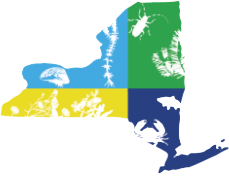Citizen scientists record novel leaf phenology of invasive shrubs in eastern U.S. forests
Research Summary by Abby Bezrutczyk
Summary
Putting leaves out early in the spring and keeping leaves later in the fall is known as extended leaf phenology (ELP), and this tactic gives many invasive shrubs advantages in photosynthesis and competition. Because leaf phenology varies with geography, in this study Maynard-Bean and colleagues went beyond local observations and used citizen science data to predict regional-scale patterns; they investigated how ELP of 8 native and 6 invasive shrubs changes with latitude, and how environmental factors contribute to leaf emergence and leaf off. To make an experiment of this scale possible, the team worked with citizen scientists in the USA National Phenology Network to collect 1500 observations on leaf emergence and leaf fall across the northeast region over 4 years. They found that, on average, invasive shrubs had leaves on for 77 days longer than native shrubs. But when it came to latitude, observations made at more northern latitudes trended towards less difference in phenology between native and invasive species. In the spring, the difference decreased by 2.9 days per degree northward, and by 2.2 in the fall. They found no difference in leaf emergence between invasive and native shrubs with changing pre-season warmth, however, an increased number of chill days (days with an average temperature of 0 and 10˚C) did predict earlier leaf emergence of invasive shrubs at northern latitudes.
Key Takeaways:
- Having leaves earlier in the spring and later in the fall (extended leaf phenology) gives advantages to invasive shrubs.
- Invasive shrubs in the Northeast have their leaves an average of 77 days longer than native shrubs.
- As one moves north, the difference in phenology between invasive and native shrubs becomes smaller; invasive shrub phenology is less extended.
- As climate change progresses, increased chill days at northern sites could extend the leaf phenology of invasive shrubs and confer advantages.
- Citizen science campaigns can help advance unique research, requiring effort in soliciting, training, and communicating with volunteers.
Management Implications:
- Extended leaf phenology can be a “green target” for detecting, removing, or treating invasive shrubs while native species are dormant.
- Identifying horticultural shrubs that have ELP can help predict invasive potential.
- Invasive honeysuckle, privet, and burning bush are prohibited or regulated in NY but are still in the horticulture trade in southern areas, where their leaf phenology is more extended. These findings can help guide policies to limit the trade and establishment of these shrubs in these areas.

